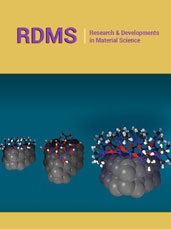- Submissions

Full Text
Research in Medical & Engineering Sciences
Natural Polysaccharide Based Dry Powder Inhaler Excipient
Chen Zheng and Li Ya*
School of Materials and Chemical Engineering, Ningbo University of Technology, Zhejiang, China
*Corresponding author:Li Ya, School of Materials and Chemical Engineering, Ningbo University of Technology, Zhejiang, Ningbo 315211, China
Submission: January 16, 2025;Published: January 28, 2025

ISSN: 2576-8816Volume11 Issue4
Abstract
Natural polysaccharides, serving as excipients, can improve the drug performance of DPI formulations. Polysaccharides like chitosan and hyaluronic acid are commonly used for drug loading, and their nano/micro particles can be prepared normally by methods of spray drying. A novel method of cellulose microspheres with nanopores was introduced in detail. Despite researches on polysaccharide excipients for DPIs has seen significant progress, their clinical application remains limited.
Keywords: DPI excipient; Polysaccharide; Cellulose; Microsphere
Introduction
Dry powder inhaler (DPI) has many advantages, such as high bioavailability, no first-pass effect, propellant free and environment friendly, which has been regarded as the most promising pulmonary drug delivery application for future use. In the formulation of DPIs, excipient is one of the most important ingredients to develop inhalation preparations to improve the stability, mechanical properties and dose reproducibility of the drug substance. Natural polymers such as polysaccharides are extensively studied as promising excipient for the targeted delivery of drugs to lungs due to their biodegradability, biocompatibility, low toxicity, bio-adhesive properties and the ability to load with various pharmaceutical preparations. Chitosan (CS), alginic acid (Ag), hyaluronic acid (HA) and cellulose especially HA and CS are the most commonly used to polysaccharides load or encapsulation drugs [1]. HA and CS particles can be produced by spray drying of aqueous polymer solutions and bioactive molecules. HA is a polysaccharide naturally present in the lungs and it is reported that the spray dried HA particles with insulin can form an inhalable dry powder containing 10% (weight/weight) of drug. The application of CS in the delivery of various drugs, vaccines, genes and chemotherapy drugs has been extensively studied. The preparation of CS nanoparticles can be prepared by spray drying complexes with electrostatic interacted polyanions, CS’s positive charges attach to negatively charged mucosal surfaces provide mucoadhesive characteristics, prolonging medication release for greater bioavailability [1,2]. With reference to spray-dried emulsions, the production of small and yet polydisperse particles remains challenging as polydispersity tends to be accompanied by a less controlled particle growth [3].
Cellulose has also shown promising physicochemical and aerodynamic properties for the pulmonary delivery of drugs. Cellulose nanofibers or nanocrystals are commonly prepared by chemical hydrolysis to disrupt amorphous domains or mechanical treatment such as high-pressure homogenization or grinding, to induce the disintegration of bulk structure [4]. However, cellulose nanoparticles prepared by these methods have high crystallinity and agglomeration degree and it is suggested that cellulose nanofibers exerted acute toxicity when administered through pharyngeal aspiration and progression of inflammation response in vivo respectively. The optimal particle size for dry powder inhalation is generally considered to be in the range of 1 to 8μm which ensures effective lung deposition and maximizes therapeutic efficacy [5,6]. Recently, we prepared monodispersed nanoporous cellulose microspheres with controllable diameters of 1 to 5μm by an emulsion membrane method, without any chemical crosslinking, as illustrated in Figure 1. The loading rate of hydrophilic drugs such as folic acid reached more than 30% and the storage stability was greatly improved. The better aerodynamic characteristics of the cellulose microspheres satisfy the requirements of the secondary particles intended for inhalation-based drug delivery systems. But there is still a need to investigate them for in-vitro, ex-vivo, in-vivo and toxicity studies to achieve a market approval.
Figure 1:Cellulose microspheres preparation process using membrane emulsion method.

Discussion
The development of polysaccharide excipients for dry powder inhalers (DPIs) in pulmonary drug delivery has attracted significant research attention, yet their clinical application remains limited. Despite extensive efforts, only a few products have been able to enter the clinical stage. One major challenge faced in translating these excipients into clinical applications is the limited number of excipients approved for pulmonary delivery. Introducing new excipients involves significant scientific and financial risks, requiring large investments and extensive toxicological testing. Additionally, further in-depth research on the long-term biocompatibility and safety profiles of these excipients is necessary to ensure their safety for human use over extended periods. Therefore, the translation of polysaccharide excipients from research to clinical applications faces significant hurdles, and ongoing research and development, coupled with strategic investments and collaborations, are needed to overcome these challenges and advance the field of pulmonary drug delivery.
Conclusion
The formulations of polysaccharides complex can greatly increase the loading rate and the stability of the drugs and improve the ability of the drug to reach the target of the lung. The polysaccharides are expected to be widely used in DPIs preparation. However, there are some limitations of the normal spray-dry preparation of the dry polysaccharides powder particles and it is necessary to develop more applicable and efficient polysaccharides particles with unique structure. It is hoped that more polysaccharides based DPIs can be approved to clinical applications.
References
- Encinas BD, Eedara BB, Mansour HM (2024) Biocompatible biodegradable polymeric nanocarriers in dry powder inhalers (DPIs) for pulmonary inhalation delivery. Journal of Pharmaceutical Investigation 54 (2): 145-160.
- Rasul RM, Tamilarasi MM, Zakaria Z, Shah K, Chee CF, et al. (2020) A review on chitosan and its development as pulmonary particulate anti-infective and anti-cancer drug carriers. Carbohydrate Polymers 250: 116800.
- Shah K, Chan LW, Wong TW (2023) Conversion of liquid chitosan-based nanoemulsions into inhalable solid microparticles: Process challenges with polysaccharide. International Journal of Biological Macromolecules 253(Pt: 4): 126991.
- Balde A, Kim SK, Benjakul S, Nazeer RA (2022) Pulmonary drug delivery applications of natural polysaccharide polymer derived nano/micro-carrier systems: A review. International Journal of Biological Macromolecules 220: 1464-1479.
- Elsayed I, AbouGhaly MHH (2015) Inhalable nanocomposite microparticles: preparation, characterization and factors affecting formulation. Expert Opinion on Drug Delivery 13(2): 207-222.
- Yadav D, Wairagu PM, Kwak M, Jin JO (2022) Nanoparticle-based inhalation therapy for pulmonary diseases. Current Drug Metabolism 23(11): 882-896.
© 2025 Li Ya. This is an open access article distributed under the terms of the Creative Commons Attribution License , which permits unrestricted use, distribution, and build upon your work non-commercially.
 a Creative Commons Attribution 4.0 International License. Based on a work at www.crimsonpublishers.com.
Best viewed in
a Creative Commons Attribution 4.0 International License. Based on a work at www.crimsonpublishers.com.
Best viewed in 







.jpg)






























 Editorial Board Registrations
Editorial Board Registrations Submit your Article
Submit your Article Refer a Friend
Refer a Friend Advertise With Us
Advertise With Us
.jpg)






.jpg)














.bmp)
.jpg)
.png)
.jpg)










.jpg)






.png)

.png)



.png)






